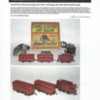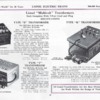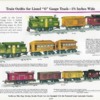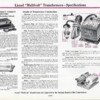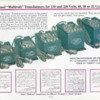Recently, I've been planning on buying a prewar Lionel No. 150 Electric locomotive. Along with it, I wanted to buy the necessary items needed to replicate the original set the locomotive would have come with. I am planning on the freight set, and already have an 800 Boxcar and an 801 Caboose scouted out, but I still need some information on what transformer/rheostat came with the set. If anyone could fill me in, or maybe direct me to where I can obtain this information, that would be greatly appreciated.
Replies sorted oldest to newest
There is an out of print book: Greenberg's Guide to Lionel Trains 1901-1942 Vol. IV Prewar Sets. However, it goes for around $100 and sometimes quite a bit more. Outside of that, there's this little thing called "Google"...
I was under the impression that many prewar sets didn't come with power supplies as househould power wasn't standardized enough yet. I never looked myself. Don't know where I developed the thought either, but it's there. So, if you don't find the listing, you can guess why anyhow.
Adriatic posted:I was under the impression that many prewar sets didn't come with power supplies as househould power wasn't standardized enough yet. I never looked myself. Don't know where I developed the thought either, but it's there. So, if you don't find the listing, you can guess why anyhow.
There were an array of prewar transformers, from the A type to the V type. I believe that the very original lionel trains, either the 2 7/8ths inch gauge and maybe early standard gauge used a wet-cell battery to power the locomotives, but that was deemed unsafe, and lionel went to using transformers. I have a "Type A" transformer, and was wondering if that was the same used in the set, which I believe it might be. Is there any online copy of a catalog I can view? I know of a youtuber called "Master Luke" who often shows snippits of the catalog listings related to the train he is reviewing in the video, which means there is in fact an online copy floating around somewhere, though I have yet to find one that isn't stuck behind a paywall.
Mr. Berkshire,
How does one get in touch with you? There's no e-mail address in your profile.
TRW
I know the were made, just not too sure they were in the sets themselves.
I run a pre war Z . My pals Dad used a notched postion type (I think a B?) and rheostat for fine tuning that setting.
But I think I came across the thought while researching Jefferson Transformers looking for examples of thier prewar powerhouse. I spotted one on a table in a youtube video on old supplies once, but the darned comments wouldn't work so I could tell the guy what he actually had. Somewhere else that same day someone had mentioned that power wasn't included in early train sets . The scenario fit and I bought it because it seemed pretty logical, too much varience in home power. You had dc, and ac of varying hertz from east to west coast.
To throw another spin on why I found it logical; the "old family house" didn't get electricity till the mid 60s. No "city plumbing" till this century. It was too costly or "impossibe" to do it; too secluded.
I thought large dry cells were the dc supply used most rurally. I even recall a post by someone from Arizona or other desert state saying they were using the batteries into the late 50s or early 60s as they didn't have power either. But I'm aware a wet cell might explode more easily then, not to mention the fumes health detriments. Again, it makes sense. I'll let you know if I see print to help confirm one way or another, or get lucky enough to spot the info. Good luck.
With the loss of some of my favorite info sites over the last year or two, I wonder if there isn't a publisher witch hunt on info published by the little guy. It would be easier to close shop and shut up about it than fight a law team for your not so much for profit hobby info. Just too many gone too quickly for me to accept it as folks passing on, etc.
Another hobby of mine went through a similar phase and the key company kept it quite for about 3 years before someone said screw it, and spoke up (and got sued for it, but you can't squeeze a dime from a nickle so he spoke anyhow, then others did too; and the company lost a lot of face with it's largest support group for a few years. I hope it's just coincidence.
Actually, I had also wanted to warn you of a few things I knew the brass hammer would be after you about, but couldn't for lack of email, and pointing would have just shook things up and wouldn't have given you a chance to do it before being told. Oh well.
And fyi, you aren't the only furry fan around here. (not me) (also funny because I was thinking of the Soupy Sales "Black tooth" character the day you first posted that big "smile".)
Start a new email and link it to your old main, that way if an idiot does get out of hand you can toss it and start fresh with another, leaving your main account(s) needed to continue with the same name, intact. (Close the main and you have to sign up again or wait till the brass can help.)
PaperTRW posted:Mr. Berkshire,
How does one get in touch with you? There's no e-mail address in your profile.
TRW
I don't use my email very often, but I have a discord. I'll give you both, and try to remember to check my email. If I don't respond, use the discord.
Avithefox29@gmail.com
Berkshire#8117
Feel free to message
Adriatic posted:
But I think I came across the thought while researching Jefferson Transformers looking for examples of thier prewar powerhouse.
Yeah, I've seen one on ebay, with a lionel rheostat. Let me get a pic for you

Adriatic posted:I know the were made, just not too sure they were in the sets themselves.
I remember hearing in a video by "Master Luke" that the 150 Set came with The loco, two cars, track, a, and a rheostat. Looking back at the video, I don't think he said anything about there being a transformer in the sets at all. Which is good, cuz that means one less thing I need to buy.
Adriatic posted:And fyi, you aren't the only furry fan around here.
Well, this is awkward....
Who's the other one? I didn't expect to find any here, but I guess the rumor is true that they are in fact everywhere on the internet, and I'd be glad to meet a fellow fur like myself who shares the same passion of model railroading as I do!
I know many prewar Flyer sets came without transformers but did have rheostats
I sent a mail to Avi, ok Berk?
Maybe that's the origin of my thought, thanks Papa Steve.
There is actually a Jefferson transformer inside a hardboard power company building, red brick paper, and a porch lamp that lights when it's on. Ive only seen two my whole life, neither in very good shape. But there is just something about them I find alluring. Powerhouse transformers were made by a few companies in the tinplate era...but most used tin vs hardboard and paper ![]() That one does look to be about the right size for it though.
That one does look to be about the right size for it though.
I have a "midget" by Jefferson. Still "nailhead" post switched, but internal posts, done by a slider vs a swing handle. It died last year and I haven't looked at it yet. It died once about ten years ago too. But when I went to work on it, it decided to work again as soon as it got plugged in. I couldn't get it to stop again by banging, inverting, shaking, sliding the handle vigorously, or other forms of violence; so I put it to work again. I just hope Im that lucky again. Not much to do inside as it's mostly encapsulated coils with cloth tap wires emerging from the solid black insulation. "goop". If the cord goes, the thing is useless for sure. Youre not digging to the bottom of that crap without doing damage.
There was a boxed set- 150 engine with two 600 cars included a #81 rheostat type B transformer and track- set #160. Dakota Paul had one listed back in 2016 or so...
Wait, if the B type was included with the first lionel set, what was the A type used for?
Standard gauge maybe?
According to the 1924 catalog type A was for O gauge only. 1920 catalog doesn't list it at all
1924 also lists outfit #259 with 150 and one 901, one 801 but no transformer
Where are you getting these catalogs, and can you send me them?
From ebay and train shows. Give me a day and will scan a few pages to you via this forum so it helps others too..
Thanks! This is greatly appreciated, to have some scanned catalogs on hand. Will do me good in the future
Berkshire posted:Wait, if the B type was included with the first lionel set, what was the A type used for?
Standard gauge maybe?
Where are you getting that the B Transformer came with "the first Lionel set"? (BTW, that was in 1915, two years before your 150 loco was first produced.)
If you're trying to piece-meal together a period-correct set, there are literally dozens of variables to consider, especially since the 150 loco was catalogued between 1917 and 1925.
I don't believe any 150 sets came with a transformer... only the #88 rheostat.
TRW
Sorry bout that, I guess I need to fact-check more often!
And maybe find a better source of information, too
The listing appears misleading...? If so, my apology
Attachments
I wonder if there are any outfits with the A type. and if not, that's fine, I can just buy B type
and since we're at it...the 1920 copy is via TCA reprint 1969. The 1924 reprint is via House of Heeg 1975 and no I don't take these catalogs as gospel so please don't go there...
Attachments
What you need is the Greenberg's prewar hard bound catalog books Vol. 1,2 and 3. They are getting cheaper and you can find them on Ebay. They originally sold for $110. each. If you are really into prewar you also need to get Greenberg's new hard covered book,"Lionel Trains O Gauge Vol. 1 1915-1928." I have them all. There is nothing better.
Berkshire posted:Sorry bout that, I guess I need to fact-check more often!
And maybe find a better source of information, too
What would help greatly at this point is to state what you're trying to accomplish. It seems to have drifted from your original request of which transformer came with a 150 set.
eddie g posted:If you are really into prewar you also need to get Greenberg's new hard covered book,"Lionel Trains O Gauge Vol. 1 1915-1928." I have them all. There is nothing better.
Agreed.
TRW
PaperTRW posted:What would help greatly at this point is to state what you're trying to accomplish. It seems to have drifted from your original request of which transformer came with a 150 set.
Well, I was just seeing what items came in a 150 set, as I want to replicate one with items bought off ebay
Berkshire posted:PaperTRW posted:What would help greatly at this point is to state what you're trying to accomplish. It seems to have drifted from your original request of which transformer came with a 150 set.
Well, I was just seeing what items came in a 150 set, as I want to replicate one with items bought off ebay
Then that's easy, if you're not concerned about making a period-correct set. For the 150 freight set, the contents were:
1917-19: 150, 800, 801, (8) OC Curved, 88 Rheostat.
1920-23: 150, 800, 801, (8) OC Curved, (2) OS Straight, 88 Rheostat.
Each outfit also came with a set of O Gauge Track Ties (retaining clips), a replacement light bulb for the loco, and a "Directions" manual.
TRW
I've never understood the operation of those pre-war transformers. Did the lever make contact with each of those studs ? Was power to the rails lost when the lever was between two contacts ?
Dan Padova posted:Did the lever make contact with each of those studs ? Was power to the rails lost when the lever was between two contacts ?
Yes and yes.
The "ancient" transformer's action is actually closer to being prototypical really. Johnson bars, diesels, electrics, and at least some trolleys all had "throttle notches" vs a smooth sweep. I don't even know what would have an "infinitely" variable throttle.
The coil might be a direct wire multi tap vs an arm riding each wrap of coil wire for fine variable. There are pigtail wires spliced in along the secondary windings and covered by more wire till the next wire count # for X volts, then a pigtail is spliced in, repeat, etc, etc. Then each post gets a wire. Each wire carrys a different voltage.
It is possible to use restance too. Alone or with multi tapping.
Ive seen ni-chrome restance windings in some old supplies (I don't know a lot of them with covers on. I saw more apart and cover upside down than assembled) The windings look kinda like the one Sylvester is hanging from (forgive the non tinplate example please)
The wire terminal posts on the sides allow a variance, allowing you to choose various combos of windings (similar to the 0-11v vs 5-15v of a 1033). Ive seen about 10 taps on some small "universal" industrial transformers. Striped wire had to be used...out of solid colors lol.
There is usually a constant voltage capability on the ancient ones too.
Terminals are common, acc, low volt, high volt.
Attachments
John H. Shetler posted:and since we're at it...the 1920 copy is via TCA reprint 1969. The 1924 reprint is via House of Heeg 1975 and no I don't take these catalogs as gospel so please don't go there...
Thank you so much for these! I didn't see them when you originally posted them a few days before, so sorry for the late reply. I saw a lot of great material in here, and am going to keep them on me for future reference. The outfit No. 174 really peaked my interest, and I might make it some time. But one thing at a time, and that's the No. 160 or the No. 161 Outfit. Will update you on my progress, as I'm hoping to have it done by Christmas. Many thanks!




